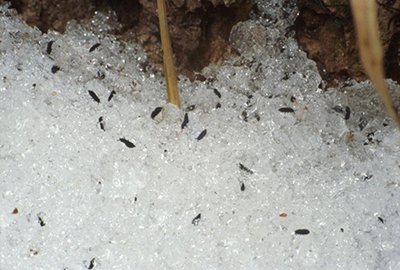Creature Feature: Snow Fleas
The snow flea (Hypogastruna nivicola) is a springtail species that is active in winter and easily seen against white snow. A primitive insect, the snow flea is very small, about 1/10 inch long, and dark blue-gray in color. They have a somewhat plump body and small compound eyes comprised of only eight facets in each. Snow fleas are wingless and are classified as hexapods, which is a subtype of the arthropod family. Like insects, snow fleas have six legs, but researchers say they are more closely related to crustaceans.
Contrary to their name, snow fleas are not actually fleas. Their name is derived from their ability to jump by using a forked appendage under their abdomen called a furcula. Facing forward, the furcula is held in place by a clasp-like structure known as a retinaculum. When the furcula is released, it propels the snow flea up and forward. A snow flea can jump up to several inches.
Generally found in groups, snow fleas are a harmless species that become more active as soon as the ground begins to thaw in late winter or early spring. Although they exist throughout the year, they are more easily noticed during snowy winter months.
Probably the most interesting thing about snow fleas is their ability to thrive in the winter, dotting melting snow instead of remaining in a period of dormancy like their insect and arthropod cousins. This is because snow fleas produce their own type of antifreeze, a protein that is rich in the amino acid glycine, which prevents the formation and enlargement of ice crystals.
Snow fleas live in the soil and leaf litter where they eat microscopic fungi, algae and decaying organic matter. For this reason, snow fleas are commonly found in wooded areas where there are rotting leaves and logs. Snow fleas can also be found in mulch. Watch for snow fleas especially around the base of trees.
Snow fleas are beneficial because they break down organic matter, helping to enrich the soil. Keep in mind: While not parasitic and thus harmless to people and pets, snow fleas are attracted to maple syrup and can sometimes be pests in buckets of sap during harvest.
These little black specks on the snow are known as snow fleas. These tiny arthropods are commonly seen on warm winter days on top of the snow layer.


